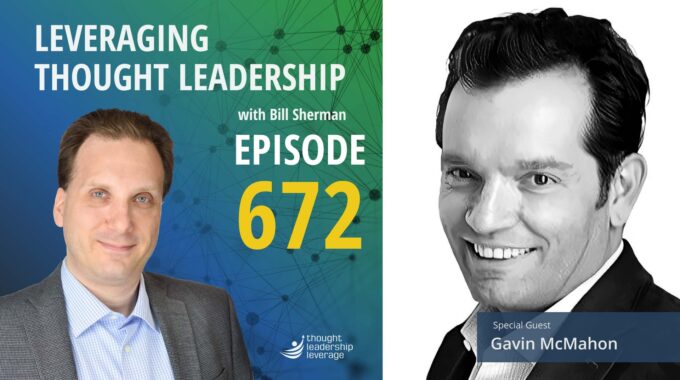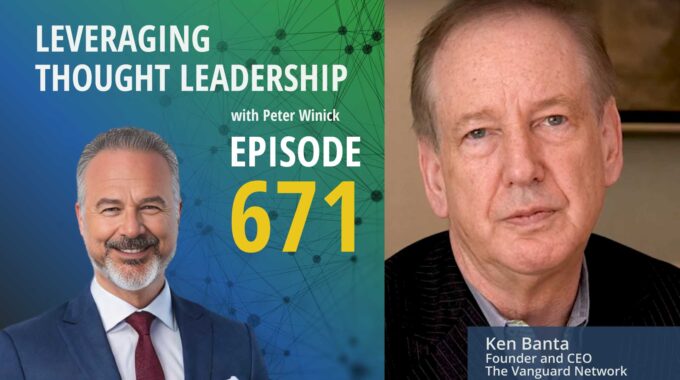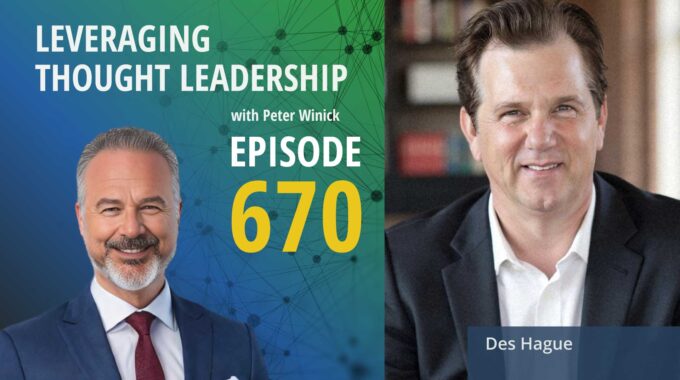How Storytelling Turns Smart Thinking into Real Influence Great ideas don’t win — great stories…
Rethinking Incentives: What Leaders Miss About Employee Engagement | Stephan Meier
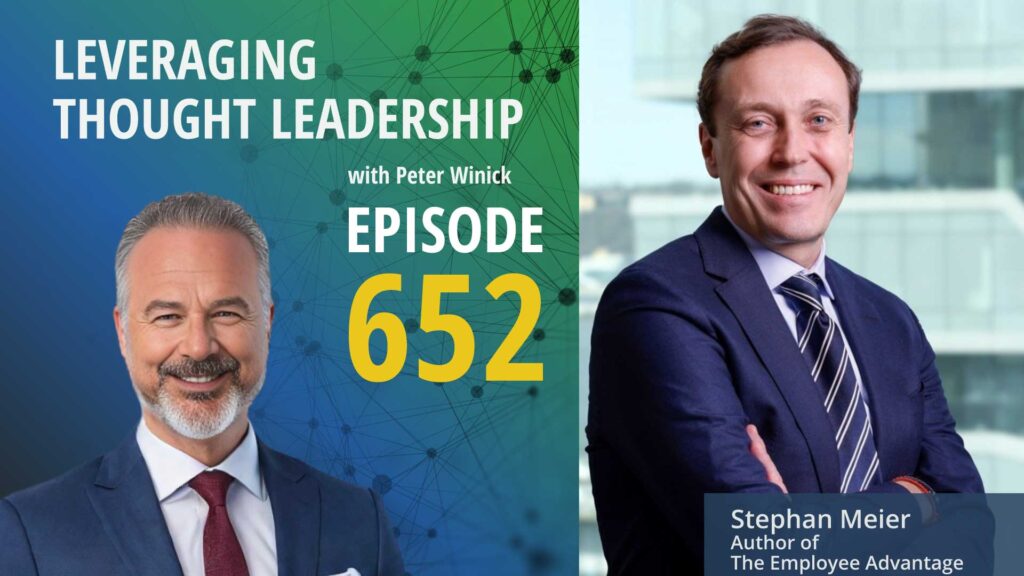
Why Smart Leaders Are Ditching Bonuses for Better Work Design
This episode explores how behavioral economics can help leaders move beyond pay and perks to truly engage employees through autonomy,
purpose, and personalized experiences. It’s a practical look at humanizing work to drive better performance.
Are your compensation strategies sabotaging employee engagement?
In this episode of Leveraging Thought Leadership, host Peter Winick sits down with Stephan Meier, Chair of the Management Division at Columbia Business School and a leading voice in behavioral economics. Stephan shares insights from his journey—from academia to the Federal Reserve to corporate advisory—exploring how behavioral science can reshape the way organizations understand motivation, incentives, and employee experience.
They dive into why traditional, money-centric reward systems fall short—and how many leaders still default to outdated playbooks. Stephan challenges organizations to look beyond perks and pay, and instead design work environments that leverage autonomy, purpose, and learning.
The conversation introduces the concept behind his new book, The Employee Advantage, and draws a powerful parallel: Treat employees like customers. Personalize their experience. Listen deeply. Improve constantly. 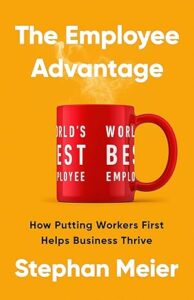
This episode offers practical, research-backed ideas that any leader can implement to drive performance, engagement, and retention. If you think a ping-pong table is the answer to your culture problems, think again.
Three Key Takeaways
Money isn’t enough – Beyond a certain point, financial incentives have limited impact on motivation. Intrinsic drivers like autonomy, purpose, and learning matter more.
One-size-fits-all doesn’t work – Just as customer experience is personalized, employee experience should be too. Engagement improves when organizations tailor motivation strategies to individual needs.
Culture is built through systems – Perks like ping-pong tables won’t fix disengagement. Real impact comes from designing systems that listen to employees and support continuous improvement.
If Stephan Meier’s insights on behavioral economics and humanizing the workplace sparked your interest, you’ll want to check out this powerful conversation with Ryan McCarty and Mark Goulston.
While Stephan focused on the science behind motivation and engagement, Ryan and Mark dive into the heart of it—how purpose, empathy, and service can transform leadership and culture. It’s a natural next step in rethinking what truly drives people at work.
Discover how servant leadership can elevate your impact and deepen connection across your organization: Listen to the episode!
Transcript
Peter Winick And welcome, welcome, Welcome. This is Pelter Winick. I’m the founder and CEO at Thought Leadership Leverage. And you’re joining us on the podcast today, which is Leveraging Thought Leadership. Today, my guest is Stephan Meier and Stephan is the chair of the management division and the James P. Corman professor of business strategy at Columbia business school. He grew up in Switzerland. He has an MA in history, economics and political science and. He has been teaching and researching at Columbia for 15 years and he’s going to share with us some of his views and thoughts and experiences. So welcome, welcome aboard today, Stephan.
Stephan Meier Thank you so much for having me Peter.
Peter Winick So world, according to me, which may or may not be accurate, there’s a subset of thought leaders that are academics. That’s kind of where you fit. So tell me how that sort of happened because not all academics expand their horizons to delve into thought leadership. So tell us a little bit about that journey, those experiments.
Stephan Meier Right. Thank you so much. So, I mean, it was indeed kind of a journey and like some of the steps along my career kind of informed me about, you know, how I want to bring kind of the research that I do to inform leaders and policymakers more broadly. And the first step after I finished my PhD actually left academia. So I went to the Federal Reserve Bank in Boston. So I worked in the Federal reserve system. Here in the U S and was at the center for behavioral economics and decision-making. That was a newly formed center. You know, I’m not a macro economist, so don’t ask me anything about like inflation and I can only give you kind of the business week version of that. But I know a lot about kind of, you know, how people make decisions, what biases they have and how mistakes happen. And so while I was at The Fed, I really saw kind of firsthand. That, you know, how important it is to have like evidence-based policy making and that it’s important to like, you know, shape kind of how, how leaders think. Uh, and so that’s kind of my first array into thinking about thought leadership, you know taking my knowledge that I know from my research and expanding it outside, and then I chose to come to the business school here at Columbia. And same thing, you Like while I do I spend a lot of time in my office doing just research, thinking about with myself, uh, like writing it in academic papers, but I got really passionate about bringing that outside of my office into the classroom, but then also beyond the classroom thinking about how can I help leaders cross the globe to just be better.
Peter Winick Give an example, because one, one thing that’s really, really interesting is as a discipline, as a science, behavioral economics is fairly young, right? I mean, 30 years, 40 years, something like this, it’s not, doesn’t go back to Adam Smith, right. And was really at some level in admission that economics isn’t perfect. This concept of rational man and all this other stuff that there is psychology involved that people do weird things that people. Sort of unpredictable things that are in their self-interest economically. So talk about sort of the, the difference between teaching those concepts to students and now going out into, let’s call it the real world into the business world and doing some applied stuff.
Stephan Meier Yeah, yeah. Thank you, Peter. You know, like the beauty about economics and the standard economics, it’s relatively straightforward. Like people are like in a certain way, they behave relatively predictable. You know they’re rational. We kind of have those models where people react to X, Y and Z and whatever. The beauty of that is it’s very easy to make predictions. The not so nice beauty about the, what is not so nice is that it’s often wrong, you know, like people actually not perfectly rational. And so when you then go into the area of behavioral economics and bring psychology in, it gets messy because humans are complicated. And so that’s what I try to do then kind of helping in this realm where like we think like sometimes it’s like, you know, this is like really random what people are doing, bringing still some structure. Into how do we behave in this, you know, human way that is still predictable. Because if it’s just random, you know, there’s very little we can do.
Peter Winick Alluded to that you’re bringing this into, you know, organizations, corporations. What’s an example of an opportunity where a company, not a, an institution brought you in to say, Hey, uh, step on, help us figure this thing out.
Stephan Meier Yeah. So, I mean, I’m doing like basically related kind of two things, uh, that I’m mainly focusing on what motivates people. So like how to think about incentives in those areas. So I’m teaching also at the business school in exec at opportunities, you know, where I bring in where leaders come in and I tell them about like, how do we, can we think about monetary incentives and how can we think about when they work, when they don’t work? I now expanded this quite significantly and that’s related kind of to my newest book, which is called the employee advantage, which kind of thinks about how do people behave and how can we humanize work in order to make the organization more profitable and more successful.
Peter Winick Stay there for a minute though. So the data tells us and has told us for quite some times that people do respond primarily to intrinsic rewards, motivation, et cetera. Yet I would argue, maybe I’m wrong. Tell me if I’m among most organizations, most companies got the memo yet their compensation systems, their reward systems and all that are still largely not a hundred percent, but primarily extrinsically, you know, I will pay You know, if Stephan’s miserable, I’ll pay him more and he’ll stay. Well, maybe he wants to work from home two days a week. Like how to, how come that reaction to the data still gets them to think to stick to an old way.
Stephan Meier Absolutely. I think you’re so right, Peter. You know, like while most, I mean, I’ve never met an executive that I talked to would say like people only care about money, but the actions they take kind of reflect that notion that they think like, Oh, people would switch job if there is $10,000 more, you know, they’re all about that compensation and they kind of neglect or not focused enough of those other factors. That really motivate.
Peter Winick So what I, I would say that, you know, at some levels, right. If I was working at Starbucks for 15 bucks an hour and Dunkin’ Donuts across the street offered me $10,000 more. The $10 thousand relative to the total income is huge. Right. So in that case it would be, but most instances, assuming that 10 K is not 30% of the earnings or something like that, that’s not going to happen. So if that’s true… I would argue that the organizations are acting in a way that’s not economically sound, right? If you knew that it was better to give, cheaper to motivate people intrinsically mostly than to throw another 20,000 bucks at them.
Stephan Meier Absolutely. I think like it is really, I think, and the evidence is relatively clear. I mean, you’re absolutely, you know, on the lower end of the income distribution and income obviously is very, very important, you know, having more money makes a huge difference in their lives and also in their productivity. So actually is also good for the, for the organization to keep like, to create kind of that secure financial security that like those individuals want, but once you reach a certain level, it’s much more. About this, the problem a little bit is like, if I would ask you right now, think about a way to motivate people with money. I mean, you need 15 seconds to come up with like, I increase it by like, whatever. I create a bonus, whatever it’s a relatively easy, well-understood mechanisms. So, but the other one, think about like, how can you motivate people when you think about autonomy? You know, that’s a motivator that people have, you know, have flexibility, autonomy. Now come up with a good scheme on actually make that happen. Now that’s much, much harder because now there’s trade-offs involved, but I actually think it works better. So what I try to do now with organization is like creating kind of workshop style where they think about those motivators that the research is pretty clear that motivate people beyond money? And for them to come up with ways of actually now implementing this in their organization.
Peter Winick If you’re enjoying this episode of Leveraging Thought Leadership, please make sure to subscribe. If you’d like to help spread the word about our podcast, please leave a five-star review at ratethispodcast.com forward slash L T L and share it with your friends. We’re available on Apple podcasts and on all major listening apps as well as at thoughtleadershipleverage.com forward slash podcast.
Peter Winick So, you know, you mentioned earlier, oh, well, you know, if everybody does X, they get a 10% raise or I can come up with a bonus scheme or whatever it is, right. And number one is that assumes everything’s equal because money is equal. A dollar, you a dollar in your pocket, a dollar my pocket. So if I come up these schemes that are money is the answer to everything. It’s a one size fits all approach, right? So you mentioned autonomy. Well, if we knew that this subset of people in our company, autonomy is really important. Yet for this subset of people, they want to be more collaborative, whatever the things are. So I think you actually have to design lots and lots of things.
Stephan Meier Yeah, that’s absolutely right. You have to personalize it more. And so the analogy I sometimes use to which like bring hammers kind of that point down is, you know, the employees are kind of the new customers. So let’s talk about customers for a second. If you think about customer centricity, yes. And you let’s ask customers what they care. Now an important part, what they hear is the price. Yeah, don’t know whether it’s top or is somewhere. Customer centricity is not lowering the price. Customer centriity is figuring out what does Peter actually care about? What does really make him his experience better? And your experience is going to be different than what I care about in my experience. And so it’s this personalization aspect that led to customer centricty and it’s not lowering price. It’s increasing price afterward. The whole idea is like to make the experience better for you. And I’m totally with you. That has to be like, it’s individual. You care about certain things in your customer experience that I don’t care and vice versa. And the same is now true for employees. You know, we think about employees and employee centricity. This is not about increasing the wage. It’s about improving the experience. And you’re absolutely right. The experience that you care is very different from mine.
Peter Winick They said, based on the book, then, you know, there’s a whole body of work on customer experiences, a whole lot of work, an employee experiences, you know, lots of things. What is the employee advantage? How are you defining that? Cause it’s, it’s an interesting concept. What is it and why, why should I consider embracing it as, as a
Stephan Meier Yeah, I mean, how I define it is like, it’s really putting your employees for, you know, really caring about your day experience.
Peter Winick Yet the employees have that sound like that sounds like a poster with all due respect on the in the lunchroom yes you know we care about our people our people are not like trick really like how would I know if I’m doing it well.
Stephan Meier Well, I think you’re doing it well if you really get like engagement. You know, if you look at, I’m absolutely with you. I’ve never met an executive who doesn’t say I don’t care about my employees.
Peter Winick They’re all things that’s like, but they’ll do things that line up to that being the outcome, but they’ll never
Stephan Meier They never say that but like if you actually look in the engagement levels either is like they are lying Or they don’t know how to do it could be both
Peter Winick That employee engagement scores, when you look at Gallup and all that have in essence been flat for as long as they’ve been measuring them. So, you know, if I’m miserable, if I was on a diet five years and I was still overweight, I would eventually say something’s wrong with this diet.
Stephan Meier So the engagement levels are constantly low. They’re actually low for like a decade or more or even more. And so that’s exactly where the work happens because I do think we’re now moving into an area where like it becomes more and more important to care about the employee experience and it’s the same with customers, you know, I’ve never met anybody who says like, I don’t care about my customers. They all obviously do, but only few companies can actually pull it off. To be input-eceptic.
Peter Winick Give me an example or two of things that a company that embraces the thinking of employee advantage would be doing versus one that’s not.
Stephan Meier So let me start with an example that again starts with the customer that shows this. Okay, Amazon, they base us at Amazon, you know, very customer centric organization, not as employees, but they’re very customer centric. And when asked about what is so great about his customer base or said in one company has many quotes, but in one quote says like, the amazing thing about customer, they’re very unhappy all the time. And what he means, and so what he means with that is like, I can always learn how to get better. Now, turn this around for employees is like very few people say like, what is great about my employees is they’re unhappy, but like the same logic applies if I actually listen to my employees, I can constantly improve. So I think employee centric organizations take this very, very seriously and have mechanisms in place how to get like inputs. From their employees and constantly improve. I mean, this is not a new concept in general. You know, the Toyota way, the Toyota part is exactly that. Like getting mechanisms in place so that frontline workers actually have input that improve the process. And as a result, the organization is going to be better off. And so the really employee centric organizations do that really, really well. That’s one example. Like, listen.
Peter Winick Apply that to 10 plus years ago. And I’m not picking on Google, but just use that as an example, Google, one of the things they were known for when we were in a, in a come to work environment more was, Oh my God, the amenities there’s, you know, you can get sushi and you can your drive and you could like, Oh, my God. This sounded like the greatest resort. But when you, when you looked under the hood, it was really math that said, listen, if you’re a $300,000 engineer, five or $10, I can underwrite your lunch and get another hour’s work out of you. That’s just a good investment if I’m
Stephan Meier Yeah, that’s true. Although I actually, I’m a little critical about those amenities. You know, I call those ping pong table solutions. So we’re like, nobody, well, very, very few people leave an organization or join it because there is free lunch or there is a ping pong table or a kombucha tap. People leave organizations because you know, the manager is bad. And so that’s we order the working or they don’t learn anything new. And that’s why they really leave. And those quick fixes are just not doing much in my opinion.
Peter Winick So I think you’re right, because back when we work was a thing, you would go to tour, we work office in New York, Seattle, Miami, whatever it was like, Oh wow, they’ve got beer on tap. And on Tuesdays it’s pina colada, like whatever it was like that’s really cool. And then the reality is, you know, if I want a beer, wouldn’t I rather just go home and have a beer? Like, yeah, like, I’m going to pay a thousand dollars more a month in rent because I can grab a beer. It just seemed absolutely.
Stephan Meier Have to do much more. And which is, which is a good thing. You know, hard is actually good because hard means you can differentiate from your competition. If it’s like just everybody needs a ping pong table or a beer tab. I mean, just get a beer tap, let it get a ping-pong tab. I mean that’s cheap. If that’s really the kicker, but it is not, it’s the hard work. So going back to what I said before, like having a mechanism in place to listening, you know, getting inputs from your worker and constantly improve. That’s hard. But that actually makes the real difference. Or another example will be, you know, what people read, why people often leave jobs is because they don’t learn anything new, they’re stuck.
Peter Winick Well, that’s a, that an interesting piece because you look at the friction between the organization, it says, while Stephan is a really good, whatever, accountant, and yes, you might be really good based on your productivity, the amount of work you can get done, whatever. But if you’re not learning, you’re bored and this therefore you’re stagnant. So individually you’re in conflict with the, the organizational. Eventually you’re either going to grind it out or say, Oh, I got, I gotta go somewhere else.
Stephan Meier It’s a, you’re, you were hitting the, the nail on the head. I mean, that’s part of the problem. You know, like, let’s say you’re in my team. Now, Peter is like my best worker. I mean he’s really what he does. He does really well. Why would I let you go somewhere else and learn something new? Because like what you’re doing is really valuable to me. So it needs to change kind of the mindset in the organization because eventually you’re going to leave the organization. So it hurts. The organization, including my team. So you need mechanisms in place to allow for like Peter and Stephan, you know, to learn something new and like get constantly stimulated and have what I call like those just right tasks, you know, where you always have like tasks that are ideal for your skills, but you’ll constantly want to learn new skills and new tasks.
Peter Winick Love it. Well, this has been great. I really, really appreciate you coming on today. And the conversation has been fantastic. So thank you so much. Thank you.
Stephan Meier Thank you so much, Peter.
Peter Winick To learn more about Thought Leadership Leverage, please visit our website at ThoughtLeadershipLeverage.com. To reach me directly, feel free to email me at peter at Thought Leadership leverage.com and please subscribe to Leveraging Thought Leadership on iTunes or your favorite podcast app to get your weekly episode automatically.


